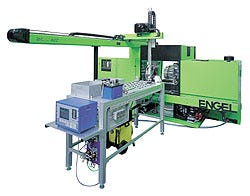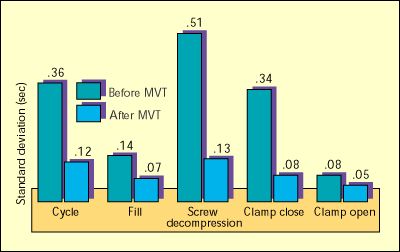May 29, 2000
Many of the latest trends in manufacturing technologies of interest to thermoset injection molders were discussed at the Thermosets 2000 SPE Retec, which convened March 22 to 24 in Chicago, IL. Molders, attendees, and speakers alike told IMM at that time that business is as good in thermosets as it is for everyone else in the molding business. Suppliers agreed, and in their presentations and tabletop displays they offered their best solutions for making things even better.
Keynote speaker Larry Nunnery, president of Bulk Molding Compounds Inc. (BMC, West Chicago, IL) told us that recent expansions will boost his company's materials production capacity to greater than 100 million lb this year. BMC has completed the assimilation of Cytec Industries' molding compound business, purchased in 1998; has opened BMC Mexico, a joint venture headquartered in Mexico City; and also has a plant coming onstream this year in Europe to better serve big accounts based there, particularly those in automotive.
|
Figure 1. Engel's John Timmerman says value-adding multimaterial and insert molding is on the rise in the thermoset industry. Fully automated thermoset manufacturing cells integrating molding machinery, robots, and downstream automation are the way of the future. |
But even with all of the good news there were words of caution. Stephen L. Sinderson of custom molder Woodland Plastics Corp. (Addison, IL) cautioned all to be prepared for the changes to come in the rising dot- com world. For anyone wondering about the impact of things like e-commerce and computer-based manufacturing, Sinderson's well-researched paper, "Computer Technology for Molders in the 21st Century," is a must read.
He addressed how developments with the Internet and its associated B2B technologies, ERP, and wireless plant-floor connectivity will change injection molding in coming years. IMM is covering these topics as part of our ongoing "Blueprint for the 21st Century" series of articles (See June 2000, page 117). Meanwhile, here are the three basic laws influencing the growth of computers on which Sinderson based his talk:
Moore's Law: The processing power of a microchip doubles every 18 months. As a corollary, computers become faster and the price of a given level of computing power halves every 18 months (Gordon Moore, Intel).
Gilder's Law: The total bandwidth of communication systems triples every 12 months (George Gilder, author).
Metcalfe's Law: The value of a network is proportional to the square of the number of nodes; therefore, as a network grows, the value of being connected to it grows exponentially, while the cost per user remains the same or decreases (Robert Metcalfe, developer of Ethernet and founder of 3Com).
Ultrasonics, Cryogenics, Recycling
Still, even in the computer-integrated future, materials will go in the shooter and parts will come out of the clamp. Many speakers proposed ways to upgrade process fundamentals. David Shepard of Holometrix Micromet (Bedford, MA) gave an intriguing presentation on his company's inmold cure monitoring systems for thermoset molding compounds. Dielectric measurements can be used to monitor changes in the dissipation factor (ion viscosity) of SMC/BMC compounds in the mold to determine the beginning and ending of cure.
Noncontact ultrasonic monitoring can be used for phenolics and other molding compounds. Ultrasonics measure the change in the speed of sound as it travels through materials as they cure. Signals generated in both techniques can be used to close the loop and open the mold more accurately.
Frederick J. Diekman of Controlled Thermal Processing Inc. (Streamwood, IL) made a presentation that dealt with the use of true cryogenic processing at temperatures of -320F or colder to reduce wear and fatigue failure in a mold's cavities, runners, gates, and ejector and core pins-even in the metal moving parts on a molding machine.
Cryogenics is surprisingly inexpensive, with typical costs starting at $6.50/lb and decreasing to $3.00/lb as the order size increases. Diekman reminded the audience that the initial purchase price of a tool is only 5 to 15 percent of the total tooling cost, which includes repairs, scrap, maintenance, and other chores. "A 10 percent reduction in maintenance costs is not very hard to achieve with cryogenic processing," he said.
Also in Chicago was Randy Lewis of P.R. Lewis Consulting (Bayamón, PR). Lewis delivered a message he feels is still lost on many OEM designers, as much as it is on many in the thermoset molding business itself. Yes, Lewis says, you can recycle thermosets. He cited companies such as Plaslok, Plenco, ICI, BMC, and Cuyahoga Plastics that have been recycling thermosets successfully and running with them.
Using hammer mills that cost virtually the same as thermoplastics granulators of similar throughputs, Lewis has found thermosets to be twice as easy to grind and reuse as ETPs that may have drying problems caused by the shape of the ground material. Lewis offered a number of charts and graphs showing the results of several experiments using thermoset recycling. All showed minimum reductions in key properties with maximum reductions in price.
"Recycling thermosets is not a technical problem. It is a matter of effort," Lewis summarized. "We can either do it or pay the same consequences we've paid for the past 25 years. With the growing importance of ISO 14000, unless we change the perception and convince the marketplace that thermosets can be recycled, our industry is headed into landfill by 3000."
|
Figure 2. Milacron's MVT can help thermoset molders clone their machines, allowing molds to be moved from one machine to another and process parameters to be optimized during setup and runoff. Archived hydraulic tuning values allow molders to identify causes of accuracy and repeatability deviations. |
Modernizing Machine Profitability
Three of the major thermoset molding machine OEMs also came to Chicago to acquaint attendees with the productive benefits of their latest offerings. Peter Lipp of Krauss-Maffei (Florence, KY) offered dramatic cost analysis graphics to prove that competitiveness and profitability can be substantially increased by using faster-cycling modern molding technology to uncover hidden assets.
Joseph A. Traglia of K-M's Fahr Bucher Service Div. also was on hand. Traglia reminded all that K-M still actively provides full service for the now-defunct line of Bucher thermoset presses in North America.
John Timmerman of Engel Canada (Guelph, ON) led thermoset molders through a review of emerging injection technologies, including inmold degating, injection compression, and cold runners. Timmerman believes that fully automated manufacturing cells are the way of the future (Figure 1, p. 124). And Tom Betts of Battenfeld (West Warwick, RI) presented a case history from customer Johnson Controls Corp., which was able to cut labor by 85 percent, reduce cycle times from as much as 4 minutes down to about 45 seconds, and reduce mold setups that took up to 4 hours down to 30 minutes. It did so using a new Battenfeld injection molding press rather than an old compression molding machine to produce identical thermoset parts.
Parts and services supplier Apex Plastic Technologies builds a popular line of stuffers now offered as standard equipment on the line of thermoset injection presses from Ferromatik Milacron North America (Batavia, OH). Tara Konowal of Apex gave a paper on cloning injection molding machines.
Using the same Machine Validation Tool Milacron uses at its plant on new equipment, Konowal said thermoset molders could develop the setup and calibration data the MVT generates to develop benchmarks for optimizing machine performance. Therefore, they can clone their machine-running the same mold in different presses with a big reduction in associated setup costs. (For a comparison of average times before and after MVT, see Figure 2, above.) Konowal also mentioned that Milacron plans later this year to introduce the first all-electric thermoset machine using Apex's all-electric stuffer.
Copies of the Thermoset 2000 proceedings can be obtained from the SPE's Publications Dept. (Brookfield, CT, www.4spe.org).
Contact information Woodland Plastics Corp. Holometrix Micromet Controlled Thermal Processing Inc. Krauss-Maffei Engel Canada Battenfeld of America Inc. Apex Plastic Technologies Ferromatik Milacron North America |
You May Also Like




